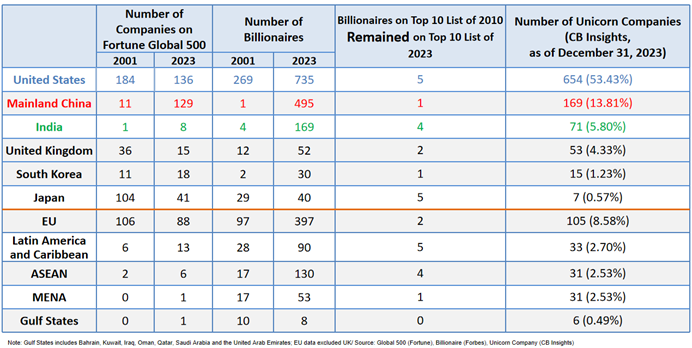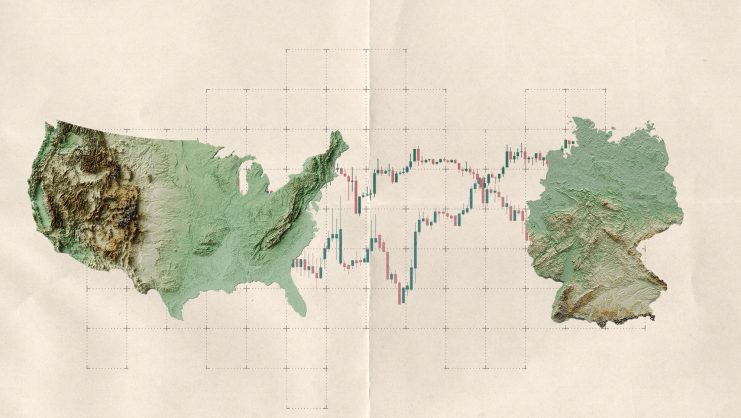China’s economy has undergone significant disruption over the past four decades, challenging the traditional notion of economic stability. While the United States is well-known for its consistent innovation, China’s rapid ascent to become the world’s second-largest economy and a leader in groundbreaking innovation has sparked global interest and discussion.
China’s GDP growth tells a compelling story; it has been ranked second largest since 2010. Data from the NBSC and BEA shows that from 1972 to 2022, China and the US contributed 19.7% and 22.5%, respectively, to global economic growth, collectively accounting for more than one-third of global output. In addition, recent data shows that China’s average contribution to global economic growth reached 38.6% from 2013 to 2021), significantly outpacing the US (18.6%) and EU (25.7%). Furthermore, China surpassed Japan in 2013 to become the world’s second-largest consumer market, with its final consumption expenditure reaching 9.52 trillion US dollars. These figures provide an optimistic view of China’s economic prospects and highlight the lucrative opportunities for businesses in the Chinese market.
World Bank statistics also reveal China’s remarkable rise in global trade. Since 2009, China has surpassed Germany as the largest export-trading nation and, in 2013, displaced the US as the top trading nation overall. This prominence has made China one of the most important trading partners, particularly for members of the Regional Comprehensive Economic Partnership (RCEP). China’s position as a major trading partner lends it significant economic leverage and makes it an essential player in global commerce.
China’s dominance in manufacturing is equally impressive. Since overtaking the US in 2010, China has been the world’s largest manufacturing hub. In 2022, according to the data from the World Bank, China’s value-added manufacturing output was $4.98 trillion, which accounts for 30.7% of the global total – exceeding the combined output of the next five countries (US, Japan, Germany, South Korea, and India.) However, China’s service sector lags behind global averages. While the tertiary industry achieved 63.87 trillion RMB in 2022, accounting for 52.8% of its GDP, this percentage is still below the global average of 61.7% in the same year.
Furthermore, increasing investment in social security programs could yield returns for China. According to the data in 2022 after benchmarking against the world average, if China were to match the global average in terms of investment in social security, its annual GDP could potentially increase by 1.4 trillion USD. Going beyond the global average, catching up with the US in terms of investment in social security programs would boost China’s GDP by around 4 trillion USD annually.
Economic disruption is vital for prosperity and social mobility – and, in China, the results of this disruption can be measured by three key indicators since 2001: the number of newly emerged large scale companies by Fortune Global 500 (increasing from 11 in 2001 to 129 in 2023 – while the US, Japan, and EU numbers decreased), the number of newly minted billionaires on the Forbes Billionaires List (from one in 2001 to 495 in 2023), and the number of unicorn companies listed by CB Insights (169 since 2015, surpassing all developed nations except the US in terms of both numbers and percentages.)
A comparison between China and India, the world’s two most populous nations, offers insight into economic disruption in emerging markets. China’s demographic profile, while facing challenges, retains some unique advantages. Despite the IMF and World Economic Forum noting that China’s population is shrinking and aging, the sheer size of its labor force makes the country resilient. China maintains an edge not only in GDP but in the workforce, with its 781 million workers compared to India’s 523 million.
Deregulation offers China significant opportunities for growth. Approximately 30 sectors in China remain to be deregulated, presenting unique prospects for foreign and private investors alike – a stark contrast to the US market.
In the realm of scientific research, China’s Research and Development expenditure has experienced a dramatic increase trend, rising from 1.03 trillion yuan in 2012 to a current 3.3 trillion in 2023 (an annual increase of 8.1%.) Chinese enterprises now account for 17.8% of the global total, surpassing the EU and ranking second worldwide. In regards to Patent Cooperation Treaty applications, out of 272,600 PCT filed worldwide in 2023, China generated 69,610.
In the field of artificial intelligence, while still trailing the US according to the Global AI Index, China ranks second. This commitment to cutting-edge technology is exemplified by companies like Bytedance, TikTok’s parent company, which was valued at $225 billion in Global Unicorn Club on March 19, 2024, a position maintained for five consecutive years. Tiktok’s unprecedented success – 672 million downloads and 10 billion USD in consumer spending – illustrates the impact of Chinese tech innovation.
China’s technological leadership is evident across multiple sectors. In renewable energy, the country accounted for 40% of the global total in 2023. Notably, China dominates solar energy, with nine out of the top 10 module manufacturers – who together held over 80% of the market share in the first three quarters of 2023 – being Chinese companies.
Furthermore, China accounted for 59% of global electric vehicle (EV) sales and manufacturers, led by companies like BYD are not only dominating domestic markets but also now challenging leaders like Tesla. China is also home to the largest EV battery maker in the world, Contemporary Amperex Technology Co., Limited, which continuously asserts its leading role in the EV battery industry by occupying a 39.7% market share.
China’s subsidies have allowed domestic producers to achieve economies of scale, while China’s import tariff has boosted its market share in the domestic market and encouraged domestic manufacturers to expand globally, enhancing its position in the international market. Both of these two policies improved China’s competitive advantage.
China’s innovation prowess is also evident in the drone industry – DJI, valued at $15 billion by CB Insights in March 2024, ranks 16th among the most valuable unicorn companies globally – and in its telecommunications infrastructure – with 5G coverage of 95% of the population by October 2023. These achievements collectively demonstrate China’s ongoing influence on future technology.
China’s fast-growing e-commerce enterprises, such as Temu and SHEIN, likewise exemplify the country’s digital innovation and global market penetration. Temu, with its strong presence in the US market, ranked as the most downloaded free app in the United States App Store in 2023. Its success is further shown by its user engagement: Temu secured the top spot in the shopping category of “App 100” with 107 million average monthly active users for the combination of IOS and Android in 2023. By 2024, Temu’s total monthly visits reached 358.2 million in 2024, with more than 40 million global downloads within a year.
Meanwhile, according to an annual ranking report published by eMarker in 2024, SHEIN, the world’s largest online-only fashion retailer, ranked fourth among all US adults, outperforming other E-commerce giants such as Facebook, Instagram, and Open AI. It’s the second-fastest growing brand among millennials and was valued at 66 billion USD as of March 2024 by CB Insights, making it the fourth most valued unicorn globally.
Despite concerns regarding income inequality which is often associated with rapid economic growth, China has shown some progress in addressing this issue. The GINI index has shown the nation move from 0.491 in 2008 to 0.467 in 2022, placing China fourth among the world’s major economies. The positive trend has spurred a series of Unicorn programs launched in China, like the Unicorn-specific Executive Program at CKGSB, the first of its kind to offer programs designed specifically for founders and co-founders of unicorns in China. China’s disruptive economic environment has created natural soil for ground-breaking innovation. The success of unicorns continues to drive economic disruption, fostering economic development and social advancement, injecting energy into the economy, and playing a critical role in promoting upward social mobility, particularly among young people. As a major global economic player, China’s collaboration with other nations to foster the next generation of unicorns is essential to generating long-term economic, social, global, prosperity, and stability.
© IE Insights.












